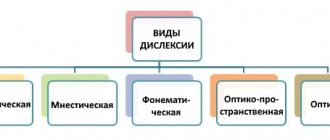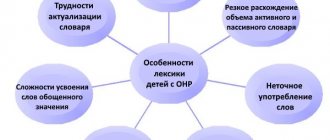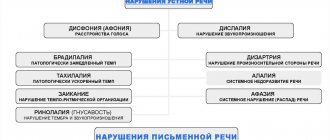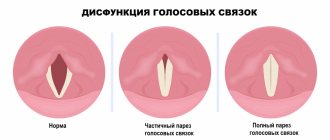Speech disorders have a varied nature depending on the degree of their manifestation, on the localization of the impaired function, on the time period of the pathology, on the presence of secondary disorders formed under the influence of the primary defect.
The modern classification of speech disorders, proposed by leading researchers, is necessary to determine primary and secondary manifestations and is represented in speech therapy science by 2 types of classification: 1) clinical-pedagogical and 2) psychological-pedagogical. When recognizing types of speech defects in typology and grouping, the same phenomena and mechanisms are considered with a different approach. Both developments do not contradict each other, but rather complement each other and show an appropriate approach to the problems of speech therapy disorders and to the selection of optimal means of correctional intervention.
It is important to distinguish speech pathology itself from all kinds of underdevelopment caused by age-related or individual developmental characteristics or insufficiently favorable environmental conditions (speech defects of close relatives, bilingualism in the family, low literacy).
Clinical and pedagogical classification
Goal: clear and detailed description of the types of disorders, taking into account the interstructural interaction of speech defects with their underlying causes, including those of a natal and prenatal nature. It is based on a number of psychological, linguistic, medical, clinical and etiopathogenetic factors that have a complex impact. All types of speech impairments are divided into 2 groups: disorders of oral and written speech (clickable diagram).
A significantly different view on the systematization of childhood deviations was proposed by R. E. Levina. Her works laid the foundation for children's speech therapy, which subsequently became a separate area with its own object of study.
Phonation disorders of oral speech in children and adults
Aphonia (dysphonia) is the absence of voice, or a violation of its strength, pitch or timbre.
It occurs due to organic or functional defects of the voice-forming mechanism. Impaired speech rate:
- – pathologically slow rate of speech, slow articulation. The result of a violation of the speech centers in the cerebral cortex. In origin, this speech disorder can be organic or functional. Speech sounds drawn out, drawn out, sluggish and monotonous;
- – pathologically fast rate of speech, accelerated articulation. Speech is hasty, rapid, assertive, accompanied by agrammatisms.
Stuttering is a disturbance in the tempo, rhythm and fluency of speech due to the convulsive state of the muscles of the speech apparatus. Most often it occurs as a sharp negative reaction to an external stimulus.
Dyslalia is a violation of the pronunciation of sounds with normal hearing and development of the speech apparatus. Distorted pronunciation of sounds, replacement of sounds or their confusion. This may occur due to anatomical defects of the articulatory apparatus or due to unfavorable conditions for speech development and phonemic hearing disorders.
Rhinolalia (nasality) is a violation of voice timbre and sound pronunciation due to anatomical and physiological defects of the speech apparatus. Symptoms of this speech disorder: monotonous and unintelligible speech, nasal tone, nasal tone of speech.
Dysarthria (tongue-tied) is a pronunciation disorder due to the immaturity of all parts of the sound pronunciation mechanism. The cause of this speech disorder is the result of damage to the central nervous system.
Psychological and pedagogical classification
Goal: to determine the most optimal ways to help people with speech pathology. The identified speech therapy disorders are grouped according to the principle from particular to general. The classification is created on the basis of linguistic and psychological factors, which take into account the structural elements of the language system. Such elements include articulatory motor skills, sound pronunciation, lexical and grammatical structure, coherent speech, and non-speech mental functions. The symptoms of the defect are identified in various types of speech underdevelopment in children. As a result, the levels of formation of individual components of the speech language system of the speech reader are determined (the diagram is clickable).
Dysgraphia and dyslexia are not defined as independent defects, since they are included in the structure of FFND and OHP as their secondary consequences. However, in practice, reading and writing defects are often identified as an independent problem. In this case, diagnosis and correction of dysgraphia occurs regardless of anamnestic data.
Thus, one of the tasks of speech therapy is to improve the systematization of speech disorders. The defects discussed above have their own subtypes.
At the beginning of the article there is a classification of speech disorders (table according to O. V. Pravdina).
Classification of speech disorders article on speech therapy on the topic
Speech plays an extremely important role in the formation of higher mental functions in a child. Performing the function of communication between a child and adults, it is the basis for the development of thinking, provides the opportunity to plan and regulate the child’s behavior, organize his entire mental life, and influences the development of the personality as a whole. In this regard, in modern special pedagogy and psychology, a position has been established on the need for early identification and overcoming of speech disorders, which are a general pattern of abnormal development, that is, they are found in the majority of children with various developmental disorders and can affect various components of speech. Some of them relate only to pronunciation processes and are found in a decrease in speech intelligibility without accompanying manifestations. Others affect the phonemic side of the language and are expressed not only in pronunciation defects, but also in insufficient mastery of the sound composition of a word, which entails reading and writing impairments. Still others are communication disorders that can interfere with a child’s schooling and social adaptation.Children with speech development disorders are a special category of children with developmental disabilities; They have preserved hearing and intelligence, but there are significant speech impairments that affect the formation of other aspects of the psyche.
Currently, in domestic speech therapy there are two classifications of speech disorders in circulation, one is clinical-pedagogical, the second is psychological-pedagogical, or pedagogical (according to R.E. Levina).
The above classifications, while differing in typology and grouping of types of speech disorders, consider the same phenomena from different points of view, but they do not so much contradict one another as complement each other, since they are focused on solving different problems of a single, but multifaceted process of speech therapy intervention .
The clinical and pedagogical classification is based on the traditional collaboration between speech therapy and medicine, but, unlike the purely clinical classification, the types of speech disorders identified in it are not strictly tied to the forms of the disease.
Thus, in speech therapy, 11 forms of speech disorders are distinguished, 9 of them are violations of oral speech at different stages of its generation and implementation, and 2 forms are violations of written speech, identified depending on the disturbed process.
- Dysphonia (aphonia) is the absence or disorder of phonation due to pathological changes in the vocal apparatus. Synonyms: voice disorder, phonation disorder, phonotor disorder, vocal disorder.
- Bradylalia is a pathologically slow rate of speech.
- Tahilalia is a pathologically accelerated rate of speech.
- Stuttering is a violation of the tempo-rhythmic organization of speech, caused by a convulsive state of the muscles of the speech apparatus (logoneurosis).
- Dyslalia is a violation of sound pronunciation with normal hearing and intact innervation of the speech apparatus (sound pronunciation defects, phonetic defects, deficiencies in the pronunciation of phonemes).
- Rhinolalia is a violation of voice timbre and sound pronunciation caused by anatomical and physiological defects of the speech apparatus.
- Dysarthria is a violation of the pronunciation aspect of speech caused by insufficient innervation of the speech apparatus.
- Alalia is the absence or underdevelopment of speech due to organic damage to the speech areas of the cerebral cortex in the prenatal or early period of a child’s development.
- Aphasia is a complete or partial loss of speech caused by local lesions of the brain.
- Dyslexia is a partial specific disorder of the reading process.
- Dysgraphia is a partial specific disorder of the writing process.
The psychological and pedagogical classification arose as a result of a critical analysis of the clinical classification from the point of view of its applicability in the pedagogical process, which is speech therapy. Such an analysis turned out to be necessary in connection with the orientation of speech therapy towards the training and education of children with speech development disorders.
- Phonetic-phonemic underdevelopment of speech is a violation of the processes of formation of the pronunciation system of the native language in children with various speech disorders due to defects in the perception and pronunciation of phonemes.
- General speech underdevelopment is a variety of complex speech disorders in which the formation of all components of the speech system related to the sound and semantic aspects is impaired.
- Stuttering is considered as a violation of the communicative function of speech with properly formed means of communication. A combined defect is also possible, in which stuttering is combined with general speech underdevelopment.
This classification does not distinguish writing and reading disorders as independent speech disorders. They are considered as part of phonetic-phonemic and general speech underdevelopment as their systemic, delayed consequences, due to the immaturity of phonemic and morphological generalizations, which constitute one of the leading features.
Speech disorders are varied. They have varying degrees of severity and depend on the cause and characteristics of the child’s development. Most often, children with speech defects come to the speech therapy center, which can be divided into three large groups.
The first group is phonetic speech disorders. They are expressed both in violation of the pronunciation of individual sounds and their groups without other accompanying manifestations.
The second group is phonetic-phonemic disorders. They are characterized by the fact that the child not only pronounces speech sounds incorrectly, but also does not differentiate them sufficiently, and does not perceive the acoustic and articulatory difference between oppositional sounds. Therefore, children do not clearly master the analysis of the sound composition of a word and make specific errors when reading and writing, often in oral speech when syllables in a word are incorrectly reproduced (omissions, rearrangements of syllables, missing endings).
The third group is general speech underdevelopment. It is expressed in the fact that the violation extends not only to the sound side of speech. The ability to distinguish speech sounds, correct syllabic formation of words, vocabulary, language grammar, and coherent speech suffers. If such a child is not provided with speech therapy assistance in a timely manner, he will not be able to fully master competent oral and written speech in the future.
To successfully master writing and reading skills, it is necessary that the child has a sufficiently developed number of speech and non-speech functions: auditory differentiation of sounds, their correct pronunciation, language analysis and synthesis, which includes phonemic analysis and synthesis, syllabic analysis and synthesis. A preschooler must have an analysis of sentences into words, a well-developed lexical and grammatical aspect of speech, a high level of development of visual and auditory analysis and synthesis, attention, memory (various types), and spatial representations. The lack of formation of any of these operations causes a disruption in the process of mastering writing and reading, leading to the occurrence of dysgraphia and dyslexia.
R. E. Levina identified three levels of general speech underdevelopment (GSD), i.e. systemic impairment of all aspects of speech with intact physical hearing.
At the first level, there is a complete or almost complete absence of verbal means of communication at the age of 5-6 years, when children without speech pathology have mostly developed speech. The vocabulary consists of sound and onomatopoeic complexes, in most cases incomprehensible to others and accompanied by gestures. Children with such features are classified as so-called “speechless”.
At the second level, commonly used words appear, albeit distorted. A distinction is made between some grammatical forms. At the same time, children's pronunciation capabilities lag significantly behind the age norm.
The third level is characterized by the presence of extensive phrasal speech with elements of lexical-grammatical and phonetic-phonemic underdevelopment. Children come into contact with others, but only in the presence of an adult and with his help. Free communication is extremely difficult.
Modern works also highlight the fourth level (T. B. Filicheva), characterized by mild lexical and grammatical disorders that make it difficult for children to master written language at the beginning of school.
Children with general speech underdevelopment have a number of psychological and pedagogical characteristics that complicate their social adaptation and require targeted correction. Inferior speech activity affects the formation of sensory, intellectual and affective-volitional spheres in children. There is insufficient stability of attention and limited possibilities for its distribution. The connection between speech disorders and other aspects of mental development is also manifested in specific features of thinking. Having complete prerequisites for mastering mental operations accessible to their age, children lag behind in the development of verbal and logical thinking and have difficulty mastering analysis and synthesis, comparison and generalization. Some children have somatic weakness and delayed development of locomotor functions; They are also characterized by some lag in the development of the motor sphere - poor coordination of movements, decreased speed and dexterity when performing them. The greatest difficulties are identified when performing movements according to verbal instructions. Often there is insufficient coordination of movements of the fingers, hands, and underdevelopment of fine motor skills.
Children with severe speech disorders exhibit deviations in the emotional-volitional sphere. They are characterized by instability of interests, decreased observation, decreased motivation, negativism, self-doubt, increased irritability, aggressiveness, touchiness, difficulties in communicating with others, in establishing contacts with their peers.
Structural and semantic disorders of oral speech
Alalia - or underdeveloped speech due to organic damage to the speech areas of the cerebral cortex in the womb or in infancy. A system of phonemic, grammatical and lexical language means is not formed. Impaired control of speech movements, which affects the reproduction of sounds and syllables. This speech disorder is more difficult to correct than others.
Aphasia is a complete or partial loss of previously formed speech skills due to vascular disorders, inflammatory processes in the brain or traumatic brain injury. Usually aphasia is called a disorder if it occurs after three years.
Another classification according to which types of speech disorders are divided:
- Impaired communication:
- phonetic-phonemic underdevelopment of speech - a violation of the formation of pronunciation in patients with any speech disorders;
- general underdevelopment of speech is a violation of the formation of all components of speech, both sound and semantic. Signs of general speech impairment: late development of speech, poor vocabulary, pronunciation defects, agrammatisms. The degree of impairment can vary from dyslalia to complete absence of speech (alalia).
- Violations in the use of means of communication - when the means of communication are formed correctly, but the communicative function of speech is impaired. This includes, for example, stuttering.
SPEECH DEFECTS IN ADULTS
In adults, speech problems arise for two reasons:
- physiological (past illness, injury or concussion);
- psychological (fear, extreme anxiety or stress).
If the reasons are physiological, then you need to seek medical help (you will need surgery or the services of an otolaryngologist).
If you have psychological problems, you need to consult a psychiatrist or psychotherapist. However, do not forget about consulting a speech therapist or speech pathologist.
SPEECH DEFECTS IN CHILDREN
It is believed that the peak activity of a child’s speech development occurs at 2.5-5 years. A normally developed child at the age of three should already be able to express himself in coherent sentences. A child should speak at least 5-10 words per year; by 4 years, the vocabulary should be at the level of 1000 words.
Up to 3 years of age, burr and lisp are not considered a speech defect and are explained by insufficient development of the articulatory apparatus (the tongue is most often located between the teeth when speaking). To eliminate these phenomena, parents are advised to carefully, unobtrusively correct errors in pronunciation, regularly pronounce words with errors, or work on individual sounds. If he hasn’t spoken before the age of three, he should be urgently shown to a specialist. Moreover, most likely, you will need the help of not only a defectologist, but also a neurologist.
We have already said that for proper speech development, adults must speak to the child clearly and intelligibly. Mangling words should not be encouraged, since over time such incorrect pronunciation will become a habit.
CAUSES OF DEFECTS
Any speech disorder has its own reasons. Depending on age, several groups of causes are distinguished.
Causes of the disorder in adults:
- severe stress;
- damage to the speech apparatus;
- trauma of a psychological or physical nature;
- contusions;
- surgical intervention;
- infectious diseases;
- deafness.
In children, speech impediment occurs for the following reasons:
- severe fear or stress;
- injury;
- neurological disorders;
- dysfunction of the central nervous system or cerebral palsy;
- infectious diseases;
- incorrect formation or damage to the speech apparatus;
- heredity;
- deafness.
Conventionally, all causes are divided into two groups: physiological (associated with damage to the articulatory apparatus) and neurological (characterized by damage to the areas of the brain that are responsible for speech and a disorder of the nervous system).






